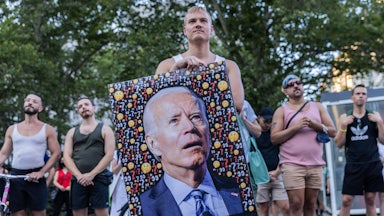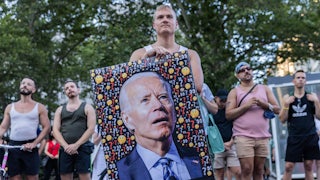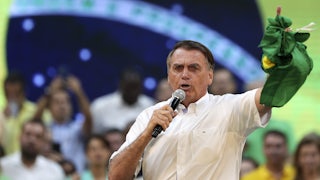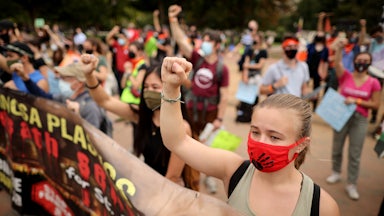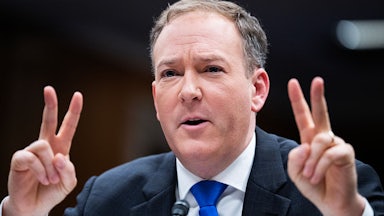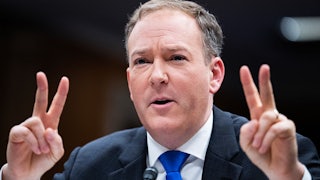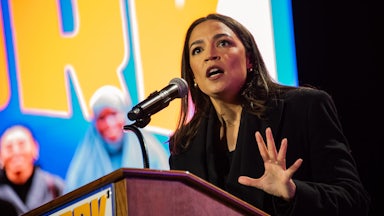It has been 82 days since the first monkeypox case of the 2022 global outbreak was detected in the United Kingdom. In that time, we’ve learned about new ways for a decades-old virus to behave. Monkeypox has moved so rapidly and predominantly within the community of men who have sex with men, the AP reported this week, that it may “represent the dawn of a new sexually transmitted disease.” Now news outlets and health experts are embroiled in a semantic debate about whether it’s really appropriate to call monkeypox “sexually transmitted.” It’s a debate that, at its core, is about who needs resources the most and how to reach them.
Monkeypox continues to surprise us, and cases are assuredly undercounted around the globe. The more this virus spreads, the higher the likelihood of unexpected kinds of transmission or mutation. But people are already suffering right now: It is vital to get vaccines and treatments to men who have sex with men, who represent the vast majority of cases, while also scaling up research and pharmaceutical manufacturing as this outbreak continues.
Arguments over whether monkeypox is an STD or not—or whether you can get it in passing at the laundromat or from sewer rats—can obscure the real issues. “I was overwhelmed by the amount of focus on this STI-versus-non-STI framing; [by] the fact that people are not outraged that vaccines, for instance, were sitting in Denmark for a month or two,” Oni Blackstock, a physician and executive director of Health Justice, told me. “The focus should really be on holding government accountable and getting them to increase the urgency with which they’re reacting to this outbreak.”
The bottom line, experts I’ve interviewed said, is that this outbreak is young and we still don’t know everything monkeypox may capable of. If we act now, swiftly and decisively, we won’t need to find out.
The fact that monkeypox is spreading in the community of men who have sex with men (often abbreviated as MSM) means we know who needs and deserves priority care right now. It also means that we have a chance to make sure monkeypox never gets elsewhere. We can do that by directing resources—including vaccines, treatments, preventative advice, and isolation support—to people currently suffering from this disease and attempting to stop the spread. “Whether this morphs into something different doesn’t necessarily inform what we should be doing today,” Jeffrey Crowley, director of the Infectious Diseases Initiative at Georgetown Law’s O’Neill Institute, told me.
The version of monkeypox recently sequenced in Europe—which is seeing 70 percent of the global cases—seems to have picked up mutations that may make it more suitable for human-to-human transmission than prior forms of this zoonotic disease, according to a new preprint study that has not been peer-reviewed or published.
Monkeypox may have then found a new niche—transmission among those with multiple sex partners, especially queer men, which is one of the more distinctive attributes in the current outbreak—and its evolution may have helped spread in this type of person-to-person contact. “Some people were quick to presume that, well, it just started here, of course it’s going to spread to the general population. And I think we need to be open, to say we don’t really know,” said Crowley.
Early in outbreaks, sometimes things just happen by chance: A virus works its way into a certain network and spreads rapidly. That pattern can stick, with an illness becoming highly associated with that network, or it can be a warning of what can happen when the next network is infiltrated. Congregate settings, like prisons and shelters, are a major concern, as well as spillback into animal reservoirs, which is poorly understood. As cases accumulate—and the United States continues ramping up testing, which has been a major weak point in the response—we could discover that the pattern so far is not just an accident and that this virus really is confined primarily to sexual contact. Early indicators are pointing in that direction, but it’s simply too soon to say. “This is, again, the biggest outbreak outside of the endemic areas in West Africa and Central Africa, and I think we’re all going to be learning as this goes along,” Blackstock said.
Monkeypox has been around for decades, and we know it is transmitted most effectively through skin-to-skin contact with sores. Emmanuel Nakouné, a virologist and scientific director at the Pasteur Institute of Bangui, told me in an email that “it is very early to say that monkeypox is an STD,” because that kind of transmission can happen outside of sex as well. However, sex seems to be a very effective way to spread it between people, because of close, sustained physical contact. And the strain now circulating in the U.S. and Europe is different from the one circulating in Africa, “with a totally different epidemiology,” which could be due to the mutations of the virus, Nakouné said. “We continue to learn about the evolution of this new variant; as time goes on, we realize that the speed of its spread is increasing.”
The virus’s evolution could also mean that this variant is capable of spreading in ways we don’t understand yet—and may continue evolving to become more virulent or more transmissible.
“Obviously, anyone can potentially get this,” Blackstock said. There has been a handful of cases among children and cisgender women, she pointed out. Close skin contact, like you might have with your kids, or with patients in a health system, or out at a nightclub on a summer’s night, could facilitate spread. It is also possible to transmit other monkeypox variants by contact with the bed linens of someone with active sores, for instance, if you’re not wearing protective gear such as masks and gloves.
“No population is immune,” Blackstock said, “but I do think that it’s probably unlikely that we’re going to see this on the magnitude that we’re seeing among MSM in other populations.” It’s a delicate balance to alert men who have sex with men of their heightened risks now, while also leaving the door open to other possible transmission scenarios—while not stigmatizing or scaring anyone, Blackstock added.
“We want to make sure that we’re being thoughtful and responsible about the information we’re giving out and that we’re not doing undue harm in terms of alarming people, and at the same time recognizing that it’s dramatically affecting a group of the population that is already obviously heavily stigmatized,” she said. “The more information people have, the better, but I think we also don’t want to go prognosticating in a way that could unduly alarm people or heighten people’s fears and further stigmatize folks who have monkeypox.”
That means being very transparent about what we know and don’t know. “One of the lessons I take from Covid is we did a terrible job telling people that science was iterative—these things are new, and we’re going to learn more, we’re going to change our mind, and that’s a sign of success, not a failure,” Crowley said.
There are also equity issues at play in the monkeypox outbreak. Blackstock, who works in Central Harlem, said she’s seen folks from outside the neighborhood get vaccinated there, “when even my own patients who are from the neighborhoods cannot get access—because they’re working, or they have other obligations that make it difficult to stand in line or keep calling a phone number or refreshing their browser screen.”
From the limited demographic data available, it seems that white men in Washington, D.C., have higher vaccination rates compared to their infection rates, pointing to inequity in vaccination rollout. Improving data on gaps like these could help target resources toward those who are at most risk of getting infected—especially if they also have worse access to vaccines.
“None of us really are safe until all of us are safe,” Crowley said. One illustration of that is the global inequity that monkeypox has once again highlighted. “This has been endemic in six countries. Now we’ve had this outbreak in 71 other countries, and more than 98 percent of the cases this year have been in those nonendemic countries.” We had highly effective vaccines and treatments available before this outbreak—but our global inaction on monkeypox made it a worldwide problem.
When it comes to emerging diseases, we need to hold multiple, sometimes competing, theories in our minds and take action based on the data available. But above all, we can’t let arguments about what we don’t know distract us from what we do know: that we need to get vaccines and treatments to those at highest risk, to expand testing for them and others, and prepare for a future with monkeypox and other unruly viruses.
We can’t predict what’s going to happen as this outbreak progresses. But we do know what can happen if we don’t respond: People will suffer, and the outbreak will grow even more unmanageable.

